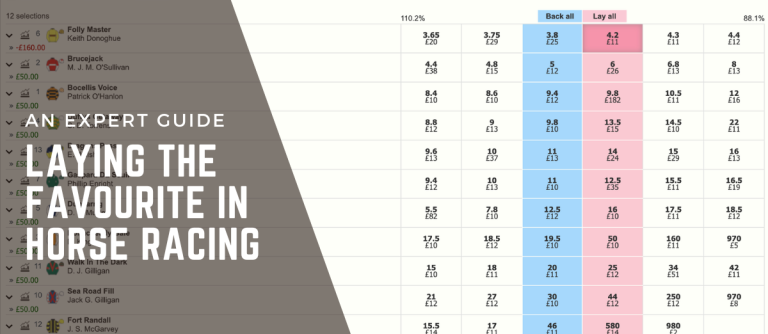Laying the Favourite in Horse Racing: Expert Guide for 2024

Introduction
Welcome to this article on laying the favourites in horse racing. This guide has taken multiple people hundreds of hours to compile. Whilst we are only showing some of the statistics found through the research process, there was a huge amount of data analysis to find these. If you’re interested in analysing this data yourself, you can access it for a small charge at the end of the article.
The aim of this article is to introduce the concept of laying the favourite in horse racing, explain exactly what it means, provide insight into the races that you should focus on and then give you some strategies to get started.
I want you to walk away feeling confidence enough to lay favourites if you feel it is something you will enjoy doing.
This research is done to support your love of horse racing, and if you have any feedback I always enjoy hearing from you. Please leave a comment at the bottom of this article.
If you have not yet registered for a free Race Advisor account, you can do this by using the button below now.
Laying the Favourite in Horse Racing Contents
What does lay the favourite mean?
Lay betting is a phrase that wasn’t heard until June 2000 when Betfair launched the first ever betting exchange.
A betting exchange is different from a bookmaker. They do not offer you odds to place a bet at. A betting exchange is a marketplace for bettors.
It matches bettors who have different opinions on an event together.
The first bettor thinks that the winner will be A, and the second bettor thinks that the loser will be B.
The betting exchange matches those two bettors together so they can place a bet.
The odds that are available are based on market demand, if more people are betting on A to win then the odds will get lower. If more people are betting on A to lose then the odds will get higher.
If you don’t think the odds are good enough for you, then you have the opportunity to request the odds you would be happy placing the bet at. There’s no guarantee you’ll get your request matched, but you can get better odds by requesting what you think they should be, and waiting for the market to move.
With that background, we now know what laying means, but what does favourite mean?
The favourite in a horse race is the horse that is considered, by the majority of people betting, to be the horse with the greatest chance of winning. It is the ‘favourite’ horse of the bettors.
Finding the favourite horse is very easy, it is the horse with the lowest odds in the race.
This horse has the lowest odds because it is the horse that has been bet on the most, making it the favourite.
Why laying the favourite can be to your advantage
It is often that the favourite becomes very popular in the betting, and this drives more people to bet on the horse.
The more people who bet on a horse, the more the odds get reduced.
In order for us to understand why laying the favourite can be to your advantage, we need to begin by understanding why people bet on the favourite in a horse race.
REASON 1: Favourite betting is very popular because the favourite wins the most races.
Everybody likes to pick a winner, and the easiest way to pick a winner is to choose the favourite.
Why?
Because generally the favourite is the strongest horse in the race.
That doesn’t mean it will always win. In fact the favourite in horse racing wins around 30% of the time. But these horses do win more often than any other horse.
Most bettors don’t do any research, so they pick the favourite as the strongest horse in the race.
This is not a good approach, but it is one followed by lots of people.
As more people bet on the favourite, we know that the odds drop.
Which is another reason why people be on the favourite.
REASON 2: Dropping odds may indicate inside information
There’s a (mistaken) belief that if the odds on a horse are dropping rapidly, then there is inside information about that horse. That people on the ‘inside’ are placing big money on the horse because it is going to win the race.
Despite there being lots of betting systems based on this, I’ve never seen any evidence that this is true.
In fact, it’s a self-fulfilling prophecy.
Bettors are betting on the favourite for reason one, so the odds begin to drop, this then makes people who think there is inside information (reason two) to start placing bets on the favourite. This increases the amount of money being bet on the horse and… the odds drop even faster!
How does this benefit you?
Because the odds can drop too low!
How odds work (the simple version)
If we remind ourselves that odds are purely a representation of the horses chance of winning.
We can find out what chance a horse’s odds are saying it has of winning by doing the following sum:
1 ÷ decimal odds
If a horse had odds of 3.50 then this sum would be:
1 ÷ 3.50 = 0.2857
This number will always be between 0 and 100 because it is a probability. To turn this into a percentage we multiply it by 100.
0.2857 x 100 = 28.57%
A horse with odds of 3.50 is being estimated to have a 28.57% chance of winning the race.
Coming back to how this benefits you…
As people keep betting on the favourite the horses odds keep dropping, at some point they will drop so low that they are now far lower than the horses real chance of winning.
For example, if a horse had a 28% chance of winning, then we know that they should have odds around 3.50.
Now imagine that this horse is the favourite and people keep on betting it. The odds keep dropping, and eventually they hit 2.10.
The odds are now suggesting the horse has a 48% chance of winning the race, when it actually only has a 28% chance of winning.
There is now an advantage to laying this horse because the odds have dropped to such a low level.
In order to explain this we are going to need to get into a little bit of mathematics. Work your way through this because it will open up a world of how to win at horse racing, not just with laying, but also betting to win.
The mathematics of profitable horse racing betting
There are two absolute truths in horse racing betting.
- It is impossible to know which horse is going to win the race
- It is impossible to know a horse’s exact chance of winning the race
In order to progress you have to know these two truths.
The first one most people don’t have any trouble with.
The second one can sometimes cause confusion. That’s because we so often see a horse’s chance of winning printed on websites. We have it on every racecard on the Race Advisor under the Horse Most Likely To Win column.
So let’s be very clear…
This figure is always an estimate of a horse’s chance of winning a race.
There is nobody who can tell you the exact chance of winning, it is always an estimate. Some estimates may be better than others, but it is always an estimate.
I’ve labored the point enough. Moving on!
Knowing these two absolute truths actually gives us freedom, because now we have room for error, there is wiggle space.
Because there is wiggle space, it is impossible for us to know if the odds are good for a specific horse in a specific race.
We may think they are good, but we don’t know for certain that they are because we don’t know what the horses actual chance of winning the race is.
This means we cannot measure our success on a race-by-race basis. We have to measure it over a period of time in order to average out the wiggle room.
The more races we do this over, the more the wiggle room is averaged out and the closer we get to the truth of how well we are performing.
If you did it over just two horses who lost, the third horse would change your results completely if it won. If you do it over 1000 horses then adding one more horse to your results isn’t going to make a big difference to the overall result whether it wins or loses.
Knowing this it becomes clear that the only way we can truly know if we are going to be long-term profitable is by looking at our average performance over a lot of horses.
For the sake of this article I am going to consider the minimum amount of horses to be 100 winning bets. Ideally it would be at least a year of betting (even if that is more than 100 winning bets).
As odds are purely a way of displaying a horses chance of winning, the concept of how to win is very simple.
To win at horse racing, over the long term we must win more frequently than our average odds suggest.
That’s it.
The actual doing it is harder than saying it, but this is all we need to do.
Let me give you an example…
If the average odds of our bets in the long term are 4.50, this indicates that the bookmakers (or betting exchanges) think our horses should win 22.22% of the time.
Let’s say we are actually winning 30% of the time, then we are winning more often than our average odds indicate we should.
And this means… you are likely to be making a profit.
Here’s the calculation over 1500 bets (roughly four or five bets per day).
Our average odds are 4.50, which means a winning bet pays out on average odds of 4.50.
Remember, we are working this out over the long term because we cannot measure on a race-by-race basis as it does not provide us enough data.
We win 30% of the time, which means we have 450 winning bets.
450 winning bets return (not profit) 450 x 4.50 = £2025 (assuming a £1 bet on each horse).
We have placed 1500 bets at £1, which we need to subtract from our returns:
£2025 – £1500 = £525
A profit of £525 has been made.
But we knew we were likely to be making a profit because our winning rate was higher than the average odds suggested they should be.
Before I close out this chapter I’d like to visit the most common question around this:
This doesn’t make sense because not every horse has odds of 4.50.
I understand this question and where it comes from. Usually it indicates that the maths hasn’t been understood, and I would urge you to have a re-read of this section.
However, for the purposes of completeness, let me show an example of why we can use average odds.
If we have ten horses with the following odds:
7.5
2.36
1.84
9.5
8
2
1.95
3.5
5.6
2.75
None of these horses have odds of 4.50, however the average odds are 4.50, which means we could expect two horses to win from these 10 (based on their odds). If we have three winners then we are into profit.
Please remember that ten bets is not enough to do this over, because a single win or loss will make a big difference to the end result. When you do this over hundreds, or thousands, of bets those single wins and losses no longer make a difference because there is significant data.
While this example has been shown from the perspective of backing to win, because the maths is simpler, it is exactly the same for laying.
All of this is to show you that the key to winning laying favourites, is to know when the odds have dropped significantly enough that laying favourites becomes advantageous to you because over the long-term the horses will lose more often than their odds suggest they should!
In the next chapter we’ll look at how, where and when you should lay favourites and how you can determine if a favourite is worth laying at all!
How does laying horses work? When and where to lay favourites
How does laying horses actually work? The nuts and bolts. The mechanics.
The best way to explain this is to walk-through an example. In this example I am going to be using Betfair, but any betting exchange will allow you to place a lay bet and the principles will remain the same.
We’re going to use this race as an example:

As you can see in the image above there is a Back (blue) column and a Lay (pink) column.
Backing is betting a horse to win. Laying is betting a horse to lose.
The reason you can only bet on a horse to lose on a betting exchange is because a betting exchange works by putting two bettors together. One bettor thinks the horse is going to win (backing) and one bettor thinks the horse is going to lose (laying). When they agree on the odds, then a bet is made between the two bettors.
A betting exchange simply works as a facilitator to make this happen. They make their money by taking a small commission (2% at time of writing) from the winner (backer or layer).
Backing horses works in exactly the same way as it would if you placed a bet with any bookmaker.
Laying in effect makes you the bookmaker.
Here’s how it works…
If you click on the Lay button for So Many Roads you will see a box like this:

This shows you the bet you are about to place, and where everything we need to know about the bet is held.
We can see that the Backer’s Odds are 4.40.
In other words, the backer is going to place a bet with us at odds of 4.40 and they want to stake £10.
If the horse wins the race, then the backer has won the bet and our liability of £34 is paid to the back.
Why?
Because the backer has placed a bet with us for £10 at odds of 4.40. If their bet wins (and the horse wins the race) then we pay them back £44. That is their £10 stake plus £34 in winnings.
Exactly like a bookmaker would pay out.
However, if the horse loses then we get to keep the £10 backer’s stake.
Exactly like a bookmaker would.
Importantly, while this information looks like it comes from somebody ready to place the bet, we are actually in control of it.
What we are doing at this stage is putting an offer into the market.
We could change the odds to 4.20 and the amount of backer’s stake to £100. This then gets submitted into the market and stays there until someone is prepared to take odds of 4.20 or we cancel our offer.
It’s possible for just some of our stake to get matched. If we’re prepared to take a stake of £100 at odds of 4.20, it is possible that only £50 of our offer gets matched. The rest will remain in the market until it is matched, or we cancel it.
Remember, this process happens very quickly, within seconds or even fractions of a second, so please make sure you are comfortable with the liability shown before you place the bet. Your liability is the maximum amount you could lose by placing the bet.
Which betting exchange should you use?
The one that is offering the best odds. For laying this means the one which is offering the lowest odds, for laying, for your horse.
If you only want to focus on one to begin with, then I would recommend you use Betfair as it is the original betting exchange and still the largest.
Weak Favourites: A Golden Opportunity for Lay Betting
With the invention of Betfair, laying came into existence. Where should you start when laying favourites is exactly the same now as it was then…
You should start with weak favourites.
And there are many of them. Look at this one:

The horse that came second, Idy Wood, was the favourite with odds of 1.20.
But there were weaknesses in that horse, which indicated it may not win the race, and that certainly odds of 1.20 were far too low to be betting it to win.
If you were backing Idy Wood to win at odds of 1.20 you would make a profit of £0.20 for every £1 bet if the horse had won the race.
By laying Idy Wood at odds of 1.20, you would have had a liability (risk) of £0.20 for every £1 you were prepared to accept.
That’s important to understand.
When you find weak favourites whose odds are lower than 2.00, laying them means you are risking less than your backer’s stakes.
If you had put £100 at odds of 1.20 into the lay market on Betfair, if the horse had won you would have had a liability to pay out of £20. As the horse lost you would have taken the backer’s stake of £100.
These opportunities are absolutely golden, and appear every single week. On average 38% of horses with odds less than 2.00 lose their races and laying them will result in only a very small loss of -1.82%.
That’s before we’ve done any work to try and find the weak ones!
But this is not the only place to find weak favourites, there are plenty of horse racing favourites that have odds of 2.00 or higher which are also much weaker than their odds suggest.
So… let’s look at how we can find which favourites are weak…
False Favourites
Before we get into the details of how to find weak favourites, I want to introduce you to the phrase ‘false favourites’.
This is another way of saying weak favourites. The two terms are interchangeable.
If we were going to be very specific we could say that a weak favourite is a horse that should be the favourite but whose odds are lower than they should be, and a false favourite is a horse that should not be the favourite in the race because there is a significantly better horse in the race.
However, for our purposes, this level of detail does not matter.
How to determine a weak and false favourite
In order to determine if the favourite is weak, or false, the best place is to start with some statistics that allow us to find the race conditions where the favourites performing significantly worse than they should.
How do you choose the right race to lay horse in?
One of the most effective ways to begin reducing the number of possible horses to consider is by looking at the statistics for horse racing conditions.
Handicap versus non-handicap races: What you need to know
We will begin by looking at handicap and non-handicap race data between 2021 and 2023.
If you were to lay the favourite in all handicaps, you would get these results:
| Selections | Wins | Win Rate | Profit | A/E | ROI |
| 16041 | 11524 | 72% | -83.61 | 0.97 | -0.23% |
Laying all favourites in non-handicap races would result in:
| Selections | Wins | Win Rate | Profit | A/E | ROI |
| 32236 | 20907 | 65% | -240.77 | 0.94 | -0.44% |
This gives us a baseline. It’s interesting to see that neither makes a huge loss, and it’s better than we might have assumed straight out of the box.
So let’s dig in a bit deeper…
Group 1/Grade 1 races
| Selections | Wins | Win Rate | Profit | A/E | ROI |
| 1288 | 877 | 68% | -13.34 | 0.94 | -0.47% |
Laying the favourite in Group 1 and Grade 1 races produces very little change to laying all favourites.
Laying favourites in other races
With no significant difference laying the favourite in Group 1/Grade 1 races, let’s look at the other race conditions.
Class 2
| Selections | Wins | Win Rate | Profit | A/E | ROI |
| 2656 | 1894 | 71% | -69.22 | 0.95 | -1.10% |
Class 3
| Selections | Wins | Win Rate | Profit | A/E | ROI |
| 4728 | 3029 | 64% | -237.04 | 0.92 | -3.00% |
Class 4
| Selections | Wins | Win Rate | Profit | A/E | ROI |
| 11511 | 7278 | 63% | -94.86 | 0.94 | -0.55% |
Class 5
| Selections | Wins | Win Rate | Profit | A/E | ROI |
| 11980 | 7939 | 66% | 19.88 | 0.95 | 0.10% |
Class 6
| Selections | Wins | Win Rate | Profit | A/E | ROI |
| 6795 | 4862 | 72% | 176.83 | 0.98 | 1.28% |
No Class
| Selections | Wins | Win Rate | Profit | A/E | ROI |
| 9293 | 6538 | 70% | -98.46 | 0.94 | -0.45% |
When we see all of the classes next to each other it becomes clear that focusing on Class 5 and Class 6 racing is where we see the best returns.
Now let’s break the details down by race type.
Flat Turf
| Selections | Wins | Win Rate | Profit | A/E | ROI |
| 8695 | 5988 | 69% | -96.11 | 0.95 | -0.54% |
Flat All Weather
| Selections | Wins | Win Rate | Profit | A/E | ROI |
| 6105 | 4202 | 69% | 134.16 | 0.97 | 1.18% |
Chase
| Selections | Wins | Win Rate | Profit | A/E | ROI |
| 7016 | 4695 | 67% | -131.10 | 0.94 | -1.00% |
Hurdle
| Selections | Wins | Win Rate | Profit | A/E | ROI |
| 11901 | 7579 | 64% | -249.03 | 0.93 | -1.24% |
The best performing race type is All Weather, where you would have made a profit of +134.16 units if you’d laid all the favourites in our sample. However, the A/E is just 0.97, indicating that these lay bets were winning less than their odds suggested they should. Meaning that this profit would likely turn to a loss over a longer period of time.
This is similar to what we have seen in other race conditions, and it’s not surprising, after all we are simply laying the favourite in every race that meets a set of basic race conditions. The market will have taken account of this information and so we’d expect a small loss over an extended period of time.
Why then show the data?
Because it gives us a starting point to build a strategy and use the FMFR Method (downloadable for free from the Resources when you log in) to push these into profit.
It’s possible to combine the information we’ve already found to find even better starting points, such as Flat All Weather Class 6 races, which produce the following results.
| Selections | Wins | Win Rate | Profit | A/E | ROI |
| 1837 | 1334 | 73% | 131.84 | 0.99 | 3.60% |
With an average of five possible horses a day, this is a great starting point for any bettor looking to lay favourites.
In the interests of length, as there are potentially hundreds of combinations, I won’t investigate other specific race condition statistics in this article, but if you’d like to do this yourself you can access the data we used to write this article, along with a simple process to find your own angles, at the end of this blog post.
Where to lay the favourite?
You can only lay a horse on a betting exchange. Traditional bookmakers do not take lay bets.
Why?
Because by laying a horse you are, in effect, becoming the bookmaker.
Current betting exchanges available in the UK are:
- Betfair (www.betfair.com)
- Matchbook (www.matchbook.com)
- Betdaq (www.betdaq.com)
- Smarkets (www.smarkets.com)
Best betting exchange to lay the favourite
Which betting exchange you are going to use will be a personal choice.
The exchange which provides the most liquidity (at the time of writing) is Betfair.
Liquidity is the amount of money that is available to be matched. If there is low liquidity you may get frustrated because your bets don’t get matched.
Aside from personal preference around how the website works, looks and feels, your decision should be based primarily on two things:
- The commission the exchange takes from your winnings
- The odds available on your selections
The commission you get charged on winnings will vary from exchange to exchange, and will also vary based on your settings on the exchange.
It is the amount of money you pay the exchange from any winnings you take out of a market you have bet into. For example, if you win a bet for £10 on a horse at 2.00, you make a profit of £10. If the commission you pay is 5% then you would pay a £0.50p commission on these winnings.
You should find out the commission you will be charged before you place a bet. You may also get discounted rates when you first register, with some exchanges offering 0% for a period of time after you first register.
Secondly, it is worth monitoring the odds available for your selections, at the time you are available to place bets, to see which exchange generally has the best odds available.
While it may take a bit of effort to do both of these things, they can make a huge difference to your bottom line and are well worth the time you spend on them.
Expert Systems, Tips & Tricks for Laying Favourites
Now you know all about laying favourites, I’d like to finish by looking at some methods for laying favourites.
In the following sections you will find five possible methods that you can use to give yourself a kick start laying favourites.
Please remember that any bet you place should go through the FMFR Method (downloadable for free in the Resources area of your Race Advisor account) before being placed.
Pick a strategy to maximise your profits
Laying the place
2nd Favourites Laying System
We start looking at this strategy by understanding the performance of laying all second favourites from our data. This is the result…
| Selections | Wins | Win Rate | Profit | A/E | ROI |
| 46047 | 36839 | 80% | -268.43 | 0.98 | -0.16% |
Not bad, and something you can probably turn into a profit if you use the FMFR method. But let’s try and make an improvement.
If we focus only on Maiden races then we get:
| Selections | Wins | Win Rate | Profit | A/E | ROI |
| 3208 | 2542 | 79% | 143.50 | 0.97 | 1.24% |
An improvement in ROI, but no improvement in A/E.
However, if we remove handicap races, which perform poorly when laying second favourites, and focus purely on class 4 races (across all race types) we see this change…
| Selections | Wins | Win Rate | Profit | A/E | ROI |
| 7940 | 6301 | 79% | 592.78 | 0.99 | 2.23% |
This is a big improvement in ROI and although small, the increase in A/E to 0.99 is important because it represents that we are winning bets inline with what the odds suggest we should be.
Whilst this means that we can expect the ROI to decrease in the long-term, this is likely to be the extreme long-term as these results are over 7940 horses. Even with this expectation, benign at an expected break-even means we are in an incredibly strong place for a potential profit.
There would be an average of 22 possible horses to consider every single day!
Where do you go from here?
You use the FMFR method, but there’s a twist!
If you’ve not yet downloaded the FMFR Method, you can do that here (for free when you have a registered account).
The twist is to only use the FMFR on the favourite, and to look for a favourite that shows strong preferences on the ground, distance and race type and who has shown continuous improvement in their Improver Graphs over the last five races.
If they also have a significantly stronger Horse Most Likely To Win score than the next best horse, that is also a positive, and… if you can confirm there performance with ratings, Race Predictor or any other tools this, again, is a positive.
What are we doing?
We are looking for races that meet our criteria where the favourite looks to be exceptionally strong, and then we are laying the second favourite.
3rd Favourites Laying System
As we move to looking at laying the third favourites, we need to remember that the average odds are going to be getting higher. This means you will have a bigger liability than betting on the favourite.
Does it make a difference to the bottom line?
| Selections | Wins | Win Rate | Profit | A/E | ROI |
| 45055 | 39005 | 87% | 130.93 | 0.98 | 0.04% |
A resounding yes.
Laying third favourites in all races produced a +130 unit profit and an ROI (return on investment) of 0.04%.
The A/E is still 0.98, so we aren’t expecting this profit to always hold, but it’s a very good improvement on betting second favourites.
Betting these horses in Chase and Flat Turf races is also pretty impressive.
Chase
| Selections | Wins | Win Rate | Profit | A/E | ROI |
| 6302 | 5400 | 86% | 417.32 | 0.99 | 1.14% |
Flat Turf
| Selections | Wins | Win Rate | Profit | A/E | ROI |
| 8120 | 7076 | 87% | 238.52 | 0.99 | 0.45% |
Hurdle and AW races don’t fare so well though…
Hurdle
| Selections | Wins | Win Rate | Profit | A/E | ROI |
| 33894 | 29346 | 87% | -1408.05 | 0.97 | -0.53% |
All Weather
| Selections | Wins | Win Rate | Profit | A/E | ROI |
| 17154 | 14814 | 86% | -546.51 | 0.98 | -0.48% |
Based on these statistics, it would make most sense for us to focus on Chase and Flat Turf races.
If we restrict ourselves further to only focus on handicap races, we see this:
| Selections | Wins | Win Rate | Profit | A/E | ROI |
| 7690 | 6679 | 87% | 411.92 | 1.00 | 0.93% |
We are now in a great position to use the FMFR Method on these horses.
Laying the field
What is laying the field?
It’s exactly what it says on the tin… laying every horse in the race for the same odds. For example, if you lay every horse in the race at odds of 2.00 and three horses get matched in-running, then you’re going to make a profit even if one of them wins.
However, getting three horses matched at odds of 2.00 in-running can be pretty tough.
So how do you do it?
First of all choose competitive races. These are races that have a larger number of runners and where the Horses Chance Of Winning on your Race Advisor racecards are very close to each other, there are no big jumps from one horse’s score to the next.
Kind of like this.

If you have horses with odds of less than 2.00 or higher than 30 then you may want to look for another race, you are focusing on races where the field is tightly grouped by ability. Practice will give you the experience of the races which work best for you.
Now focus on the top three or four horses in the market and look at their average in-running low odds for similar races where their starting price odds were similar to the current race.
You need to estimate what you think the horses odds are likely to drop to in-play, even if the horse doesn’t win.
To do this use the in-running comments, alongside the lowest in-play odds. Find races that are similar to the current race and look at the lowest in-play odds. This gives you an idea of what to expect.
Based on the number of horses you are laying will determine the odds you need to lay at. If you always use three or four horses, follow this process and then use the odds you have written down to guide you for how many horses to lay,
If there are two horses then you need them both to reach odds of at least 2.00 or lower in-running.
If there are three horses then you need them both to reach odds of at least 3.00 or lower in-running.
If there are four horses then you need them both to reach odds of at least 4.00 or lower in-running.
Using this method requires trial and error to find what works for you. I’d recommend you start with small stakes to begin with while you practice.
Dobbing system
It’s quite likely you’ve never heard of dobbing, so let me begin by giving you the details of what it actually is!
The name comes from the phrase Double Or Bust, or DOB for short.
The main principle of this method is to bet on the price movements of the race in-running instead of an outright winner.
So, with that in mind, let’s break down exactly what a DOB bet is.
DOB stands for Double Or Bust and a DOB consists of two bets:
- A back bet which is placed before a race starts
- A lay bet which is placed in-running
On occasion it can even be possible to get your lay bet matched before the race as well, but most of the time it will be matched in-play.
Traditionally dobbing would be placing your lay bet at half the odds you placed on your back bet so that if your lay bet was matched you would double your stake whatever happened.
However, based on feedback from our readers, we’ve adapted this traditional strategy to a lower risk approach. Our approach will aim to get more of your lay bets matched but require the horse to win to make a profit. If your lay bet gets matched and the horse doesn’t win then you will break-even.
This results in a significantly lower risk approach that generates slow but steady profits.
The key to dobbing is that you always place your lay bet for lower odds than you took on the back bet with a stake that allows you to make a profit should the horse shorten by enough in-running.
Let’s look at an example.
If we back a runner at odds of 5.00 for £100 before the race goes off, then we have a potential profit of £400 and a potential loss of £100.
The race goes in-play and we place our lay bet at half the odds, which is 2.50, and for the same stake of £100.
If the lay bet gets matched then we win no matter what happens.
The possible results are:
- Horse loses and gets nowhere near your lay in-play bet
- Horse loses but you get your lay bet matched
- Horse wins
In the first scenario you would have lost your £100 back bet and your lay bet doesn’t get matched. This results in an overall loss of £100.
In the second scenario you would have lost your £100 back bet, but your lay bet got matched so you would have won £100 on your lay bet. That’s a break-even position with no win and no loss.
In the third scenario you would win £400 on the back bet but lose £150 on your lay bet. This results in a £250 profit before commission, or £237.50 after commission at 5%.
To make this method of betting work, what we’re looking for can be defined as:
A way to find horses that are likely to run well (contenders) rather than specifically for horses that we want to win.
In other words… horses whose odds are likely to shorten in running.
Luckily we can do that pretty easily using the Race Advisor race cards!
Look for a race where the top three horses under Horses Most Likely To Win are the same as the top three horses in the odds, and where there is a noticeable drop between the third and fourth scores for Horses Most Likely To Win.

You then want to look at the in-running comments for each of these horses. Do this by clicking on the horses names to open the details for the horse. Scroll down to the horses past race details and look at the in-running comments.
The words you want to see are those like led, prominent, clear and made all. Any words that indicate the horse either led the race or was up the front of the field with the pace. Here is an example.

I strongly recommend you do this for all the horses so you can see if there is more than one option in a race.
How do you bet?
You place your stake on the horse to win, in the example above if our stake was £25 we would place a back bet for £25 at odds of 3.70.

To work out what odds to lay your horse at, take the profit of your win bet (£66.40 in this example) and divide it by your stake. Using this example it would give us:
66.40 divided by 25 = 2.67
We then lay the horse, for the same stake of £25, at odds of 2.67 (or the nearest).

If your odds are matched in-running then this will give you a risk free bet. You could choose to green up instead, meaning that you would change the stake on your lay bet so that whatever happens you make a profit if the bet is matched.
In this example the odds got matched but the horse didn’t win the race.

While we didn’t make the big £23.79 profit here, we did make a small £2.64, which was still a 10% return on the bet.
Free tools vs Paid Tools / How to use Race Advisor resources
It’s possible to get started using any of the approaches above using the free tools on the Race Advisor, make sure you have made an account and are logged in to get the maximum benefit.
When you are ready to level up your horse racing analysis you can use the Race Advisor’s premium tools. These are available on a day basis only. There are no subscriptions. You buy what you want, when you want it.
Conclusion – Will You Win Money Laying Favourites?
In conclusion it is clear that you can win money laying favourites, but you need to be careful in how you choose them.
Making a profit from betting on horse racing, either laying or backing, requires discipline, structure and practice.
If long-term profit is your goal, then make sure you have a long-term focus. This requires a minimum of six months using a single approach, but often it is longer.
Our most successful users use this approach when using a new method:
- Choose an approach that feels comfortable to you and aligns with your risk, bankroll and timeframes
- Practice it for 100 winning bets, keeping track of results of every bet (this can be done easily using the Race Advisor’s bet tracker)
- Analyse the results and determine your strengths and weaknesses. Focus on the strengths
- Practice for another 100 winning bets and then analyse the results
- Repeat step 4 until you are making a 5% return on investment (ROI) or more
- Congratulations you are now a long-term winning bettor!
Depending on how many races you have time to analyse each day, and your previous experience, will determine how long this process takes. It may take six months, a year, or possibly even longer.
Treat it like a business.
If you are looking to have some fun, then try practicing any of the above methods until you find the one that you enjoy using the most.










Amazing work n insights Micheal
BRILLIANT !
What can I say but WOW!!!
It’s not correct to say that if your strike rate is above the chance represented by your average odds, you will be in profit. Especially if you use level stakes betting. The only true measure is to sum the chances represented by ALL selections (expected winners) and compare to the number of winners (actual winners). If actual/expected is greater than 1, you will be in profit.
Could you point me to where I say that so I can see if there’s a better way for me to phrase it please?
‘…the bookmakers (or betting exchanges) think our horses should win 22.22% of the time.
Let’s say we are actually winning 30% of the time, then we are winning more often than our average odds indicate we should.
And this means… you will be making a profit.’
Also, ‘But we knew we were going to make a profit because our winning rate was higher than the average odds suggested they should be.’
Thank you.
Thanks to you all for all this hard work. With my studying which is not the best i got through it but downloading file not for me thanks. Geordie.
Possibly as far as dobbing goes , backing favourites lets say 3 and above should see you winning more or less a third of your dobbs , I much prefer to equalise the book btw in terms of profit ( stake x back bet / lay price) there would also be a good number of horses that dobbed but lost the race, using a 1 point staking plan you could possibley generate a profit over the day. I point staking is increasing your stake by 1 unit after a loss, not to be confused with martingale btw .
Fabulous Michael – thank you so much!
Hi. I saw that some horses have 0% at Suit the Race option. Or other horses with very low % at % likely to win,but with high % at Horse strenght
The total score is a combination of all the individual performances over good races.
So I’m quite new to this but love the statistical side too it. I just wanted to ask a question. In the stat sheet when it says for example 552 races and 1700 selections?. (This is in Flat AW Class 6 Handicap in the Fav section.) I would have thought lay the fav would only consist of 552 selections as you would only lay the fav in each race? Or am I missing something?. Apologies in advance
This sounds like there may be an error in the formatting, please contact our support team to take a look.